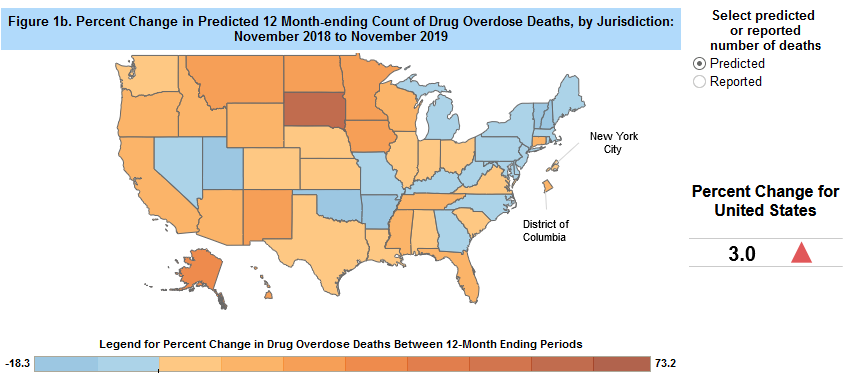Overdose Deaths Are Rising Again and the Pandemic Is Making It Worse
/By Roger Chriss, PNN Columnist
The nation’s overdose crisis seemed to ease a bit in 2018, when fatal drug overdoses dropped 4.1% compared to 2017. This was heralded as a turning point in the crisis, a possible light at the end of the tunnel of overdoses that rose annually for nearly three decades.
But new data from the CDC shows that 2019 saw increases that almost wiped out the drop in 2018. Although provisional, the data shows a 3% increase in overdose deaths between November 2018 and November 2019.
Overdoses are rising but the drugs are largely the same: Illicit fentanyl is involved in the vast majority of deaths, with an uptick in overdoses involving cocaine and other psychostimulants, too. Deaths involving prescription opioids and heroin both fell a little. Overdoses rose in the West, Midwest and South, while declining in New England and Mid-Atlantic states.
SOURCE: cdc
The early data for 2020 is mixed. Rhode Island’s preliminary data show a 22% increase in drug overdose deaths in the first quarter compared to the same period in 2018. Other states were doing better, at least until March.
Then came the coronavirus pandemic. State-mandated lockdowns, combined with reduced access to addiction treatment and talk therapy, along with loss of work and social support, were quickly seen as a perfect storm of risk factors for substance use problems, relapse and overdose, accidental or otherwise.
And that’s what is happening. Psych Congress reports that drug overdoses are up 16.5% nationwide from January to April 2020. Fatal overdoses rose by 11.4% during that period and nonfatal overdoses by 18.6%. This trend continued in early May, too.
The risks of the pandemic were recognized early. In March, Buzzfeed predicted that fatal overdoses were likely to increase during the pandemic because of disruption to recovery routines and access to treatment.
“The people who were getting help aren’t really getting any help right now at all,” said Danny Pont, who is part of an opioid treatment program in Rhode Island. “I suspect there will be a lot of relapses — and with a lot of relapses, there’s going to be an uptick in overdoses.”
National Public Radio also reported that treatment options are even more scarce during the pandemic, with inpatient and outpatient programs ill-equipped to operate under physical distancing rules.
All of this and more is now happening. The Well Being Trust has forecast an additional 75,000 deaths from overdose, alcohol abuse and suicide resulting from the socioeconomic stress of the pandemic, so-called deaths of despair.
The American Medical Association is trying to “reignite the fight” against the opioid crisis amid Covid-19. The AMA is calling on states to adopt new federal rules for telemedicine prescribing; removing prior authorizations or step therapy for treating opioid use disorder; removing arbitrary barriers on dose, quantity, and refill requirements; and allowing harm reduction strategies.
But the federal and state response to Covid-19 is a fragmented patchwork of policies, according to The Atlantic. The country cannot even agree on whether or not the pandemic exists, let alone if people should wear masks in public or engage in social distancing. And the rapidly shifting outbreaks, hotspots and epicenters of the pandemic make what little agreement there is transitory at best.
Sadly, the American response to the pandemic echoes the response to the overdose crisis. Too little science and too much ideology muddies what should be a clearly focused public health effort. As a result, 2020 may become the worst year for the opioid overdose crisis.
Roger Chriss lives with Ehlers Danlos syndrome and is a proud member of the Ehlers-Danlos Society. Roger is a technical consultant in Washington state, where he specializes in mathematics and research.




